Back to the Main Entrance
"Himmlische Verhaeltnisse"

Planetorama Hasliberg
by Klaus Kohl
Preface: This article translated into English cannot be but a "serving suggestion" (except for the members of the Ecole and foreign visitors to the Hasliberg). But if you look right out of your window or from anywhere else and can see a similar landscape you might try to accept the idea...
Since some time ago the central building "Max-Cassirer-Haus" of the Ecole d'Humanité is "crowned" by a big sphere of shiny aluminum ribbons. Especially seen from East it is remarkable to visitors. Any purpose?
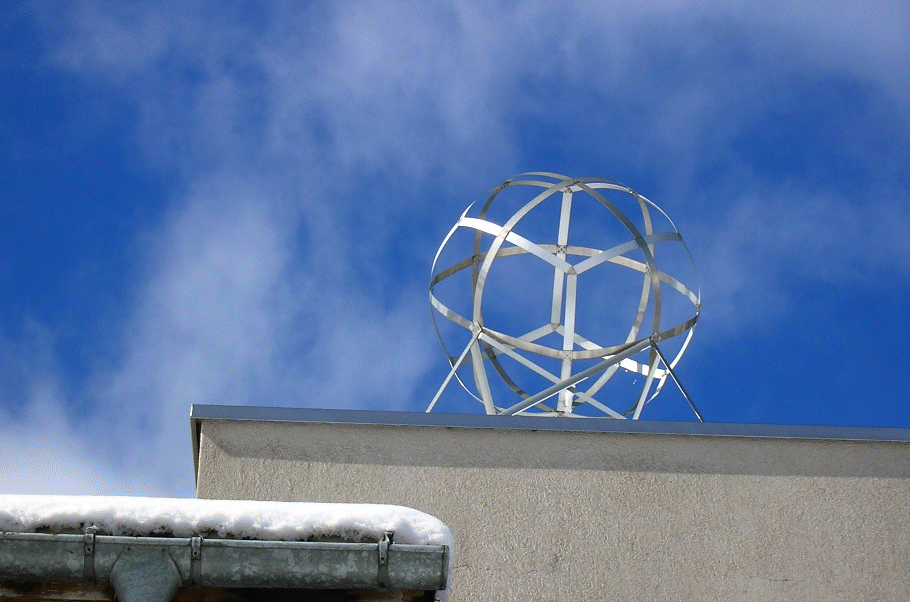
It shall represent the sun. With a diameter of 1.4 m it is by 1:1'000'000'000 smaller than the real sun (Americans, I have been taught, say 'billion' to this number, I will now adhere to this definition, although I (and some other intelligent persons) name 1'000'000'000'000 a billion...
Many locations, some schools among them, have a "Planet walk" - scale normally 'billion' - that means 1 m to move is a billion meters (Million kilometers) in the "near cosmos". There are smaller scales -just fitting to the school yard- or bigger scales in use...
Beginning at the sun in the center the "skywalker" will meet after 58 m Mercury - by the right scale a pea of 5mm diameter. Normally there is a model of it -pea-sized- and a table showing numbers of its properties. Most of us have never seen it directly as it is so near to the sun that it is under normal conditions invisible.
Following is Venus after additional 50 meters. With a diameter of 12 mm the model is a bit more remarkable. Another table with data numbers - but the sun is meanwhile "just around the corner". I think you know that shiny star and do you remember you regarded the "morning star" and the "evening star" and it took some time and/or instruction to see: It is the same star? You have been in best company with ancient astronomers!
Earth, Mars, Jupiter, Saturn, Uranus, Neptune - and if you are not too exhausted you may proceed and look whether still farther away there remained a Pluto memorial...
At least 6 km long is such a way with all its bends to reach the scaled distances from the sun.
Our Project follows another idea from where it got its name:
"Planetorama Hasliberg"
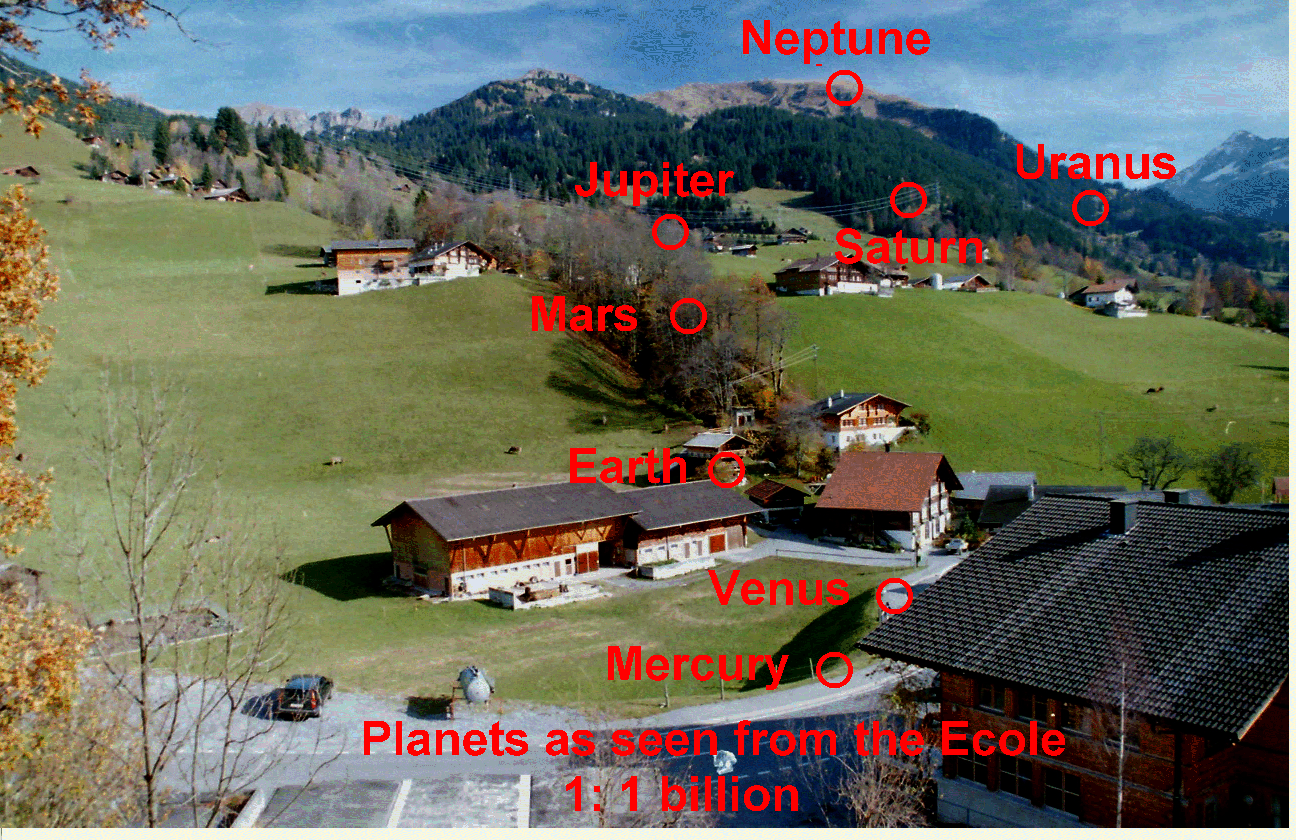 Similar to the quarter arch of a classical theater the slopes of the Hasliberg arise round about Goldern (8.16° East / 46.45° North) with a open sight from many places to the village. So it was obvious to get a map and draw the distances of the planetary system (reduced to a billionth) into it and then look where the thus obtained circles cross a public walking path and if from there could be done a look to the Ecole with its sun sphere. It was found!
Similar to the quarter arch of a classical theater the slopes of the Hasliberg arise round about Goldern (8.16° East / 46.45° North) with a open sight from many places to the village. So it was obvious to get a map and draw the distances of the planetary system (reduced to a billionth) into it and then look where the thus obtained circles cross a public walking path and if from there could be done a look to the Ecole with its sun sphere. It was found!
It is the rather well signed way from Planplatte to Schlafenbuehlen - Moosbuehlen - Gwiggi -Steinwurf - Oppersgaden - and then following the Muehlebach to Goldern.
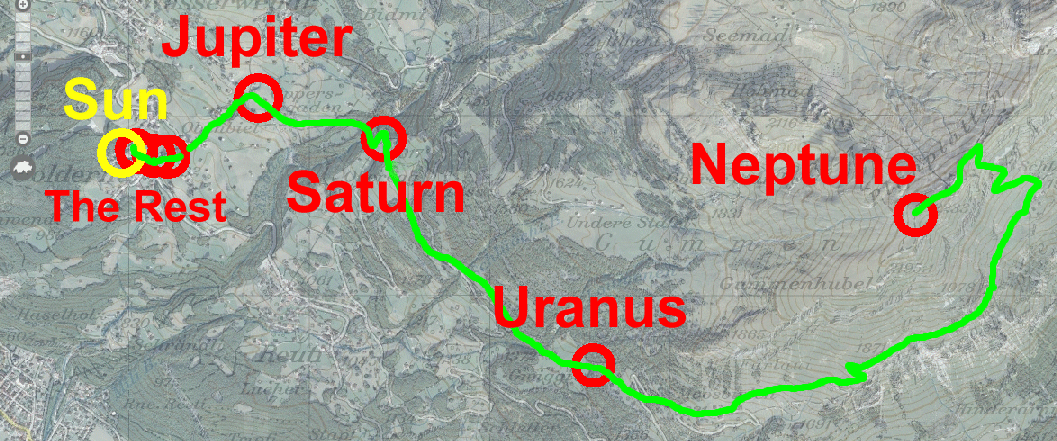
By this downhill direction it is not a straining mountain tour.
After you have been lifted from Reuti to Planplatte by cable way you may enjoy a breakfast at the "Alpentower"
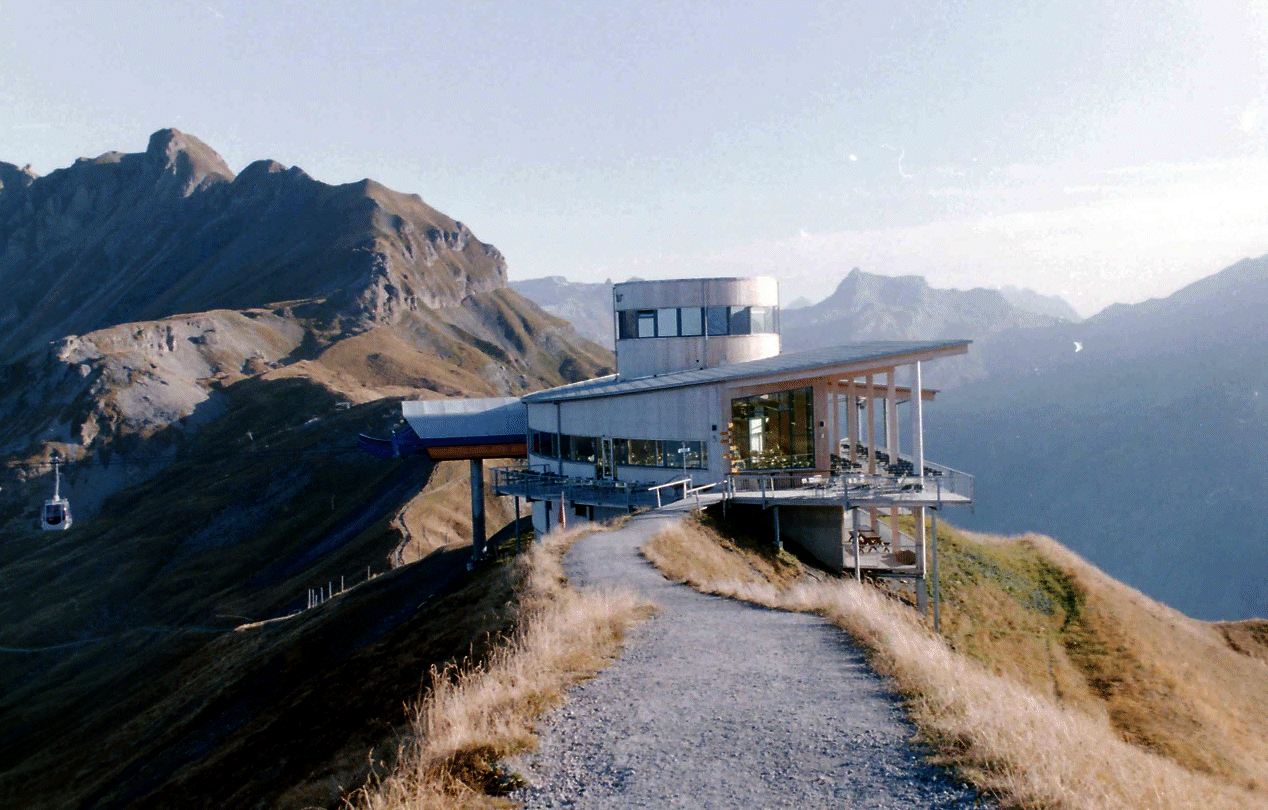
and its terrific panorama (No, sorry, a 'Neptune-Bar' is not installed there as it might evoke false imaginations...). By fair weather in summer and with mountaineering boots the way is well passable.
But missing are the usual posts with models and numerical tables as the costs of them cannot be put into a reasonable proportion to their life span (and I am not a petitioner for sponsors...). Thus the following text may give advices by the way - enhanced by the coordinates of Swiss topographic maps.
Years ago a planetary walk had to contain also Pluto – fortunately it’s obsolete now as Pluto has been disqualified as genuine planet. A tiny pea in our system not worth to get its calculated position at the Hasliberg Rothorn - from Planplatte it would be a genuine alpine tour. But you should realize: At the position of Neptune you are at the rim of the planetary system - but not at all at the rim of the solar system! Its frontiers are there where it interferes with the influence of the neighbored fixed stars. And these are very far away. The next one (not to be seen from our northern position) is Alpha Centauri, four light years away and as a light year is the distance light needs a year to run through with a speed of 300000 km/s (how many seconds has a year?) It is a distance of 10’000’000’000’000 km. Our model has 9 digits less, so remain 'only' 10 000 km for a light year. A planetary walk of our scale would have to reach around the globe to get the nearest fixed star. And as the other stars are farther away we can assume the sun reaches far, far away. But with a very low intensity. It’s a real solitude out there!
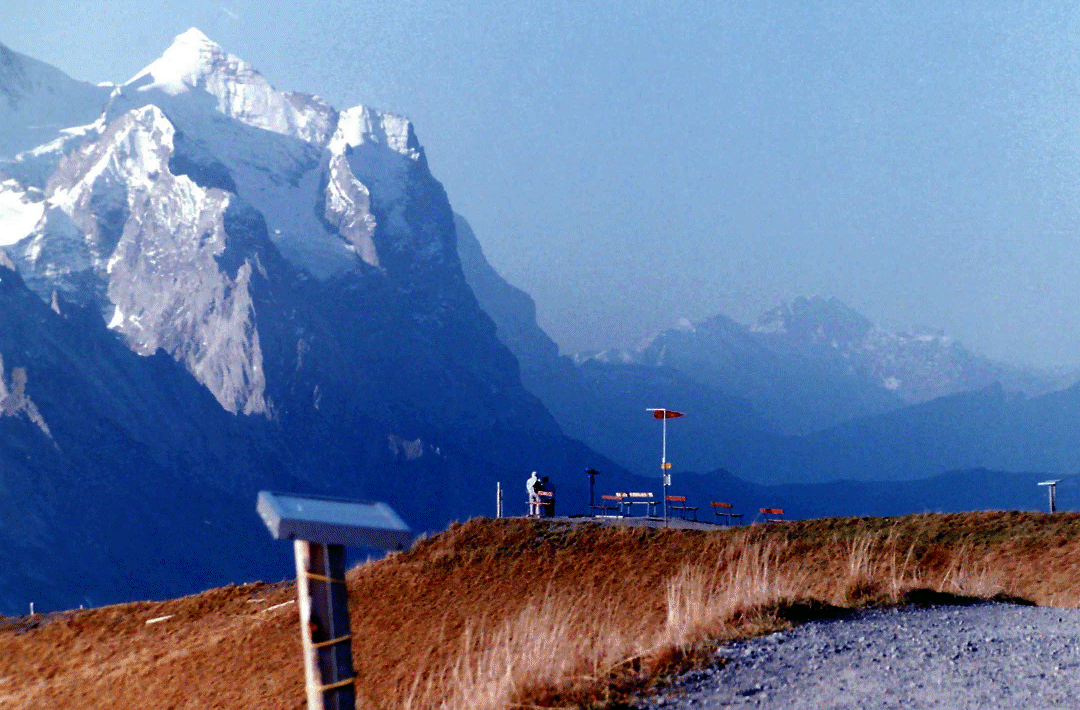
From the lookout at Planplatte (Coordinates 662360|176445) you can detect our sun globe without field glasses only when the real sun is reflected by it in the early morning.

So small the real sun would appear as seen from real Neptune.
(It is not the circle, but its center!)
A rather big point of bright light in an always dark sky. About a thousand times weaker than as seen by us. At a clear night sky it would be un Neptune as well lighted as by us beneath a thickly clouded sky. And cold! About 200 centigrade below the freezing point – brr! Oh, and our Neptune model would be rather a tennis ball, 5 cm by diameter and 4.5 km far away from the sun. So it is not surprising that one needed good telescopes to find it - additionally to an idea where to search for it. But seen had it obviously already Galilei when he observed the Jupiter moons (as we know from his notebooks). But he thought to see a fixed star.
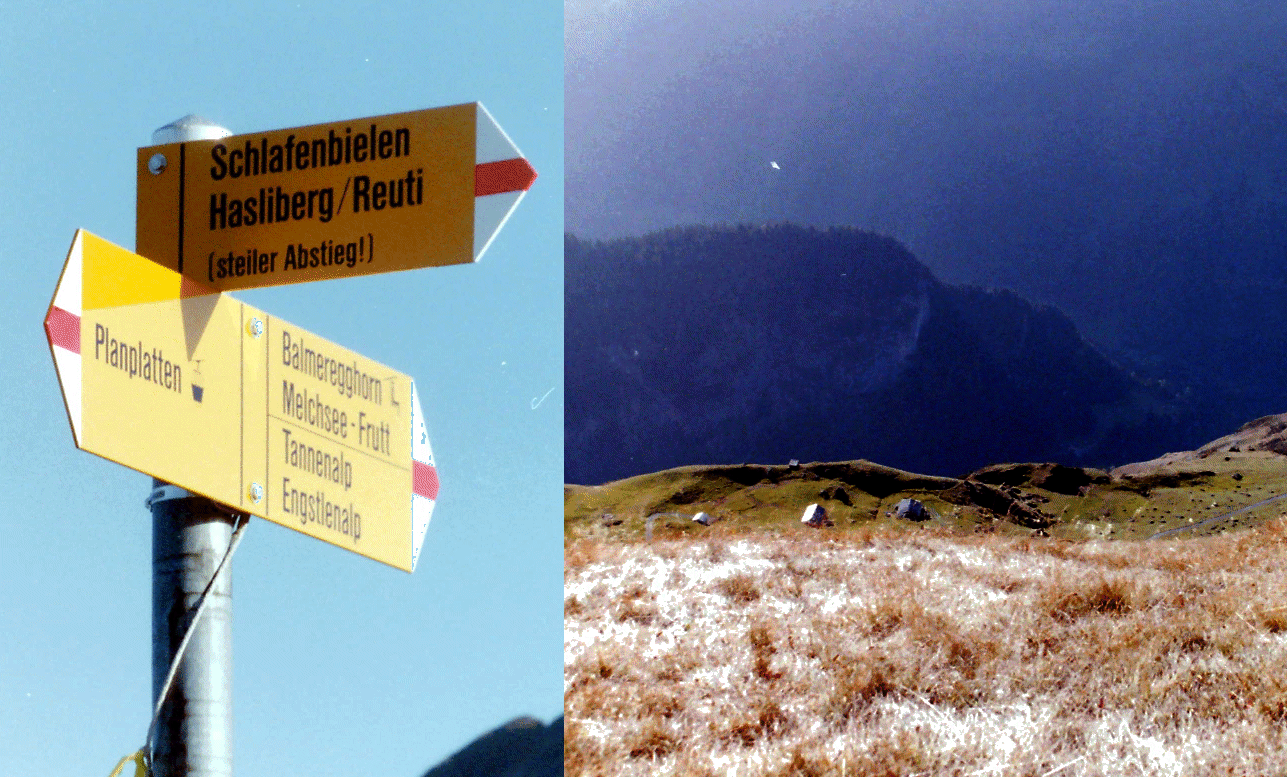
At the beginning the way down from Planplatte to Schlafenbuehlen Alp
is very steep. But this is the only difficult part of the way.
Now for a longer way you walk at the back side (the “night side”) of the mountain. You do not see Goldern but many other (known? at least imposing) alpine peaks.
But at once at the Moosbuehlen Alp

you have the view on the Hasliberg villages again. Even if here is no planet
– we are in the range between Neptune and Uranus – you should sit down and relax,
it is a fine place!
Then we have to look for a path. You may follow the road, but it is better to stay above it. Just following a dried-up brook you will reach a glade situated above the Gwiggi Alp. If you preferred to take the road you now have to ascend a little to see Goldern and the ‘sun’ again.
Here you may sit down on a rock or a stump, (coordinates 660583|175602)

look down to the ‘sun’ 3 km far and set your mind up on Uranus.
Uranus too was not detected before the use of big telescopes. The model ball, nearly of the same size as the Neptune tennis ball – we can hold it comfortably in our hand. Like all planets of the system from earth on it is accompanied by moons and since space probes have passed it we know it has a ring around itself like Saturn, but much finer.
Nothing extraordinary? Well, there is a singular fact. Its rotation axis lies nearly parallel to its orbit. And what about?
The total horror if it would be so on our earth! Imagine: It is spring time and you are by the North Pole. As normal the sun would rise – but during the next three months it turns higher and higher until - as the axis points directly to the sun - the sun is shining straight from above. After midsummer it will lower down to the horizon and from the beginning of autumn until next spring you will have the ‘normal’ polar night And you can imagine that on the antarctic side of the earth now hell will start - no night to provide some cooling! Now we leave the poles and move to the equator, searching for a better climate
What if our earth's equator would behave like the one of Uranus? In ‘summer’: While the earth’s axis shows directly to the sun, and the North Pole is overheated (the South Pole suffers its cold midnight) at the equator the sun marches the whole day along the horizon – rather cool! From now on its run becomes more and more oblique always 12 hours a day at sky, 12 hours at night. Three months later it is similar to the earth equator: straight upward to the zenith and down into a tropical night. After that more and more oblique to the horizon – and up again rising to its extreme position.
And our comfortably temperated zone? There too we have tropical days becoming longer and longer by the year and afterwards shorter and shorter... No place of an earth of that kind would be habitable! All climate catastrophes predicted to our earth would be a candy picnic compared to this horror. Let us be glad that our earth’s axis has an incline to give us an interesting change of seasons but not exaggerated!
There are some conditions meeting together to afford this fine life to us.
Let's move on!
The walk leads rather flat through a shady forest, but then a wide meadow is before us, the 'Vorsass' Steinwurf. We see the pylons of the high-tension line of the ‘Kraftwerke Oberhasli’ -the power station near by- and the pylons of the cable way which had pulled us to our starting point. And we have a new outlook to Goldern,
the Ecole and our ‘sun’. Now 1.4 km away, it is the right place (coordinates 659412|175856) to imagine Saturn.
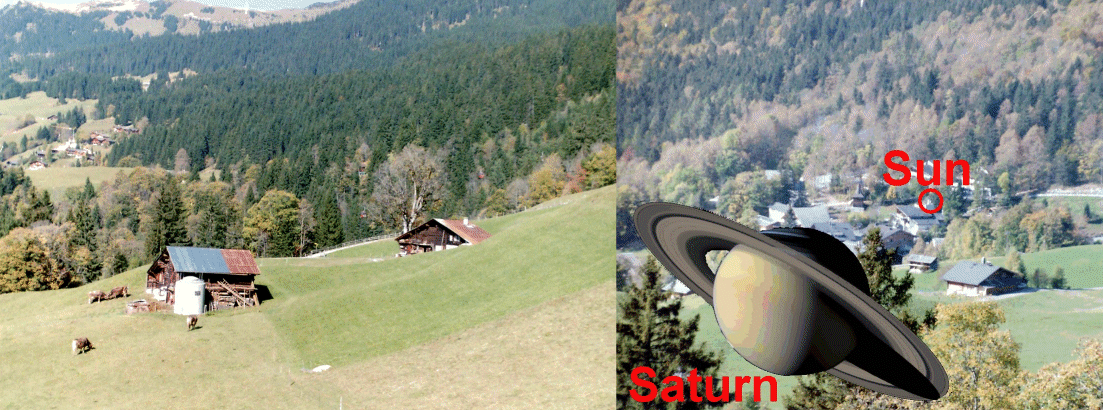
Its model would not fit into our pocket – 12 cm is the diameter of the model sphere, without the famous ring, but in our model that would be only a veal of finest dust. Made of pinewood the sphere would have the “right” weight. Since Uranus we have passed about the half way. The size of Saturn and its neighborhood – you need no telescope to detect this wanderer in our solar system. But have a look through a good telescope! A beauty! Where is the next public observatory? Ask! It’s worth visiting!
When we reach 'Jupiter' we are already on Goldern ground.
Oppersgaden is the name of the houses at the right side of the Way now named "Panoramaweg"
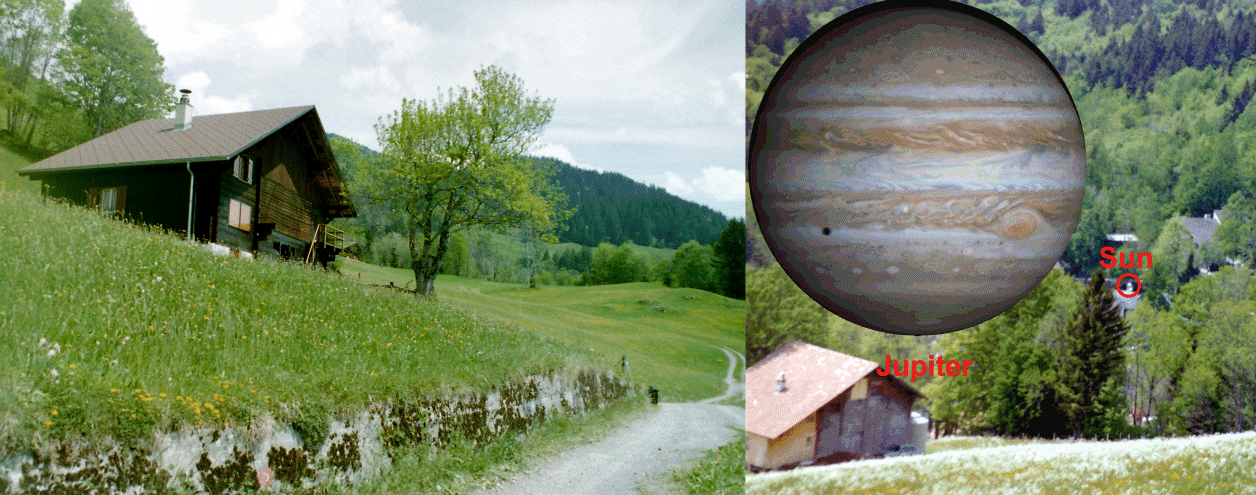
and when we can peep through the trees to the Ecole and see the ‘sun’
we are at the right place (coordinates 658700|177105) - about three fourths of a kilometer to the sun.
Jupiter is the real right bull among the planets - still a bit bigger than Saturn. 14 cm would be the diameter of the model sphere, having three times its weight... Four of its moons are so big that they can be seen by any field glasses. Galilei was the first to discover them and he believed – now, at last! – to prove to the world the correctness of the system of Copernicus... – No, it is not so simple to convince the public opinion! Nowadays these moons are even more interesting to the astronomers than its ruling center (there is even a lot of smaller moons around the Jupiter but they are counted and shortly described but obviously not worth to be investigated. Jupiter itself hides his surface under a thick layer of clouds. Has it at all something like a solid or liquid surface? We do not know. But after the 'voyager' space probes gave rather detailed pictures of the moons the astronomers could not hide their astonishment and dream to be there! Or - perhaps still better: Saturn has nut only its famous ring but a moon, named "Titan"
We continue our “planet walk” going the 'Panoramaweg' a bit back or forth (according to our appropriate Jupiter position) and follow the sign to Goldern, down along the brook Muehlebach. Had we got something into our eyes? A small fly or a grain of dust might remind us to one or more of the Planetoids. Orbiting the sun they are as well riddle and object of investigation. Johannes Kepler 400 years ago had made up his mind why the six planets known in those days had their distances from sun just this way. He found a rather well fitting geometric law and called it “harmonices mundi - harmonies of the world.” (Have you ever remarked that ‘cosmic’ and ‘cosmetics’ have the same root for ‘beautiful? – It is beautiful, isn’t it?). And then - about 235 years ago - another elegant algebraic law was found (by Johann Titius 1776 and Johann Bode 1778) describing the distances even better. But there was a gap between Mars and Jupiter. There should be a planet according to that rule – and instead of this one there is the meanwhile discovered orbit of asteroids. More and more such objects have been detected meanwhile. But until now no expert on astrophysics could give a convincing explanation of the law of Titius and Bode. “It is so, that’s it”. It is even not exact but rather well fitting. In the area between Mars and Jupiter are countless many of them - size between nearly a kilometer and small lumps of which the habitat of the “Little Prince” by Antoine de Saint-Exupéry might be the most interesting one to us. And some of them are loitering out of these bounds, but this should not disturb us, though some people fear that at any time could one of them hit our head(s).
From now on there nearly is a crowd of planets on the way, so it is recommended to use an enlarged section of the map:
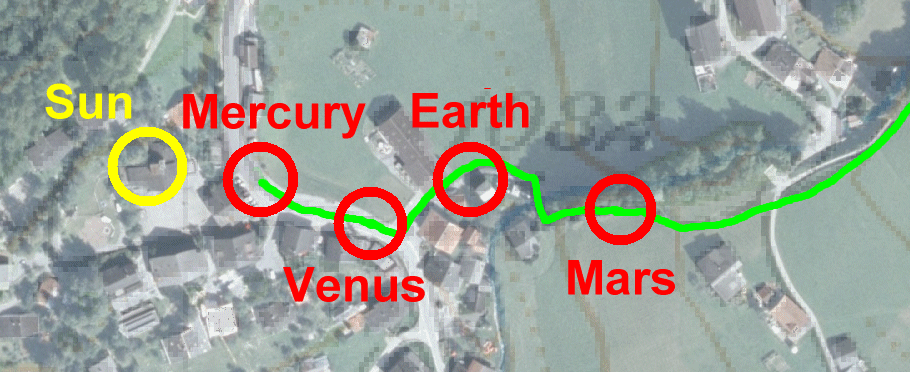
Mars is to be found on the way rather difficultly as there is no good sign nearby - about 230 m away from the Ecole.

Again peeping through the leaves of the trees (coordinates 658218|176788)
you may see the ‘sun’ or you may leave the way and stroll through the meadows, where a stick is stuck in the ground as a landmark. You better don’t go there! - It's steep and grass is a valuable resource to the people here...
The diameter of our Mars model would be about 7 mm, the so-called "inner planets" are much smaller than the "Gas Giants" outside.
Fantasies are orbiting this planet, since –more than 100 years ago- the astronomer Schiapparelli thought to see fine lines in it by his telescope and interpreted them as canals. From this time on speculations whether on Mars life would exist, never have ceased. Today no one of us will believe in those “little green men” coming with their space ships from there. But there are men believing to go there with their spaceships to be built... Another riddle about Mars: The English author Jonathan Swift 1726 in his famous book “Gulliver’s Travels” lets the astronomers of the fictional Laputa island mention two moons of Mars with rather funny orbit – and these moons had been detected about 150 years later with their really funny orbits! Erich von Daeniken, the famous Swiss science fictionist, had an explanation: These moons are not moons but abandoned space ships.
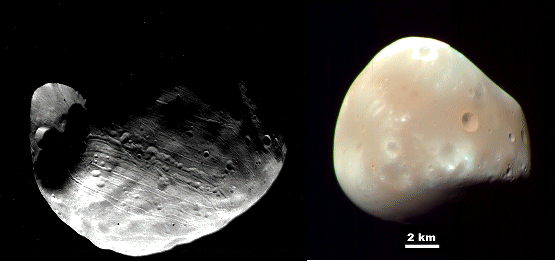
But by space probes pictures were taken – real moons, looking like huge potatoes.
Galilei however had the idea Mars should be accompanied by two moons as earth has one, Jupiter four, it would be logical...
Soon the rather steep way has gone to flatten and by the 'Stoeckli' on left hand we see the sun sphere the same size as the real sun.
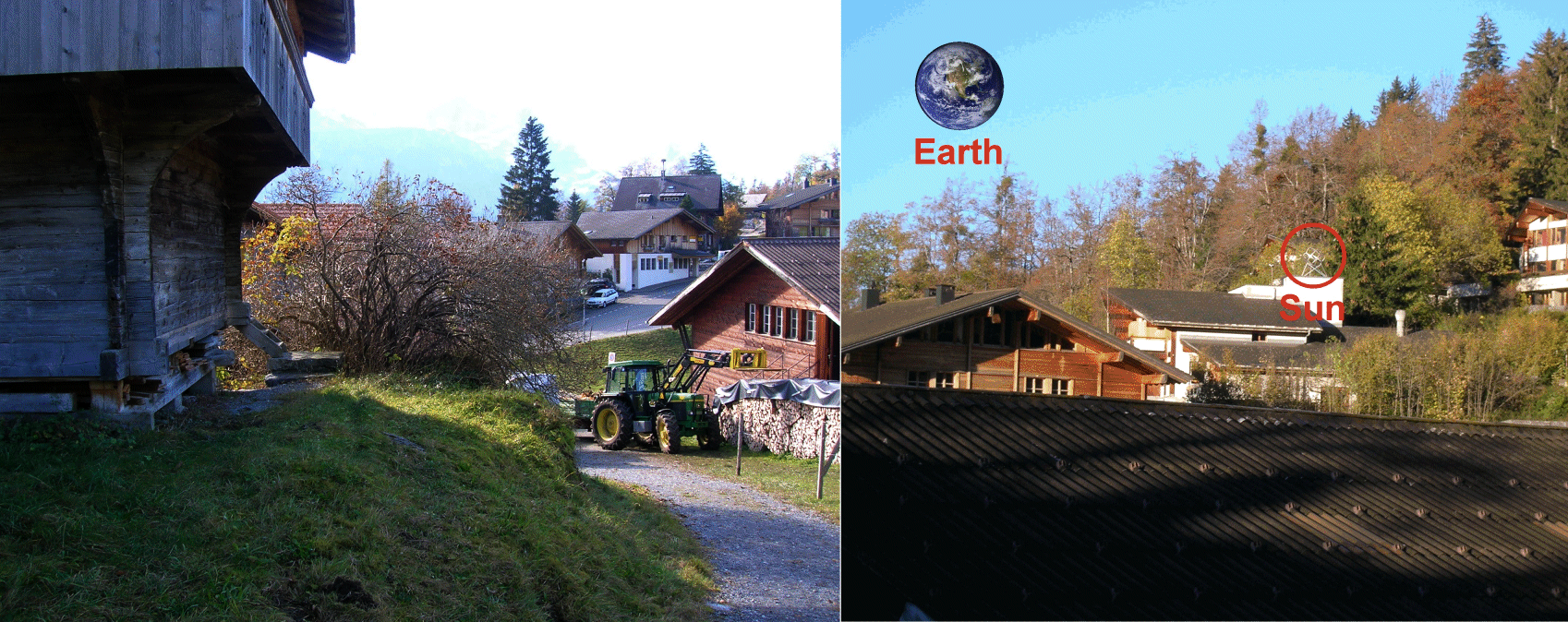
We are here (coordinates 658141|176793) about 150 m away from the Ecole – Earth!
There are perhaps little pendants shaped like an earth globe. If their diameter is 13mm, they are right. And then get a 3mm seed grain and hold it 30 cm away – that’s the moon. And now imagine further: It is by night, the ‘sun’ on the Ecole roof right before is not a skeleton of ribbons but a real sphere, and this ball of 1.4m by diameter would by its surface hold a temperature of five-and-a-half thousand centigrade! This is the temperature of the real sun’s surface. Such a thing cannot be made but we may imagine. This lamp alone would give us the right amount of light and heat. How many kilowatts this lamp would show? Nearly 300’000!
The proportional weight of the model? About 2 tons (A massive aluminum sphere would have the double weight. We should have another material, about 1.4 times as heavy as water. Thick porridge perhaps?) Now we put to our little earth model a very small little push that it will move by 7˝ minutes just 13mm – its own diameter. Then it will lie “just aside itself”. Of course this again is just imagination - by reality our ‘earth’ will fall rapidly (by the quarter of a second) to our real earth. We must think real earth away, the real sun too, only the models and the real laws of physics are present. And the pushed little earth will go its way going, going making about a whole kilometer by a year (13 mm by 7˝ minutes). But – not away, as, if we are patient enough to wait – just into our hand coming from the other side. Why? As there is no real earth to fall down it had made an orbit around our model sun in a distance of 150m: The mass of the sun model is scaled to a billionth its force is a billionth of the real sun too and as the orbit is a billionth, too, all will fit into the law of motion, Newton had detected.
There is a big temptation to leave the planet walk now and turn to the left – the Poestli restaurant – right now, but we will soon be ready!
Venus – its place (coordinates 658094|176788) is about 15 m before we reach the street lamp,
108 m away from the sun.
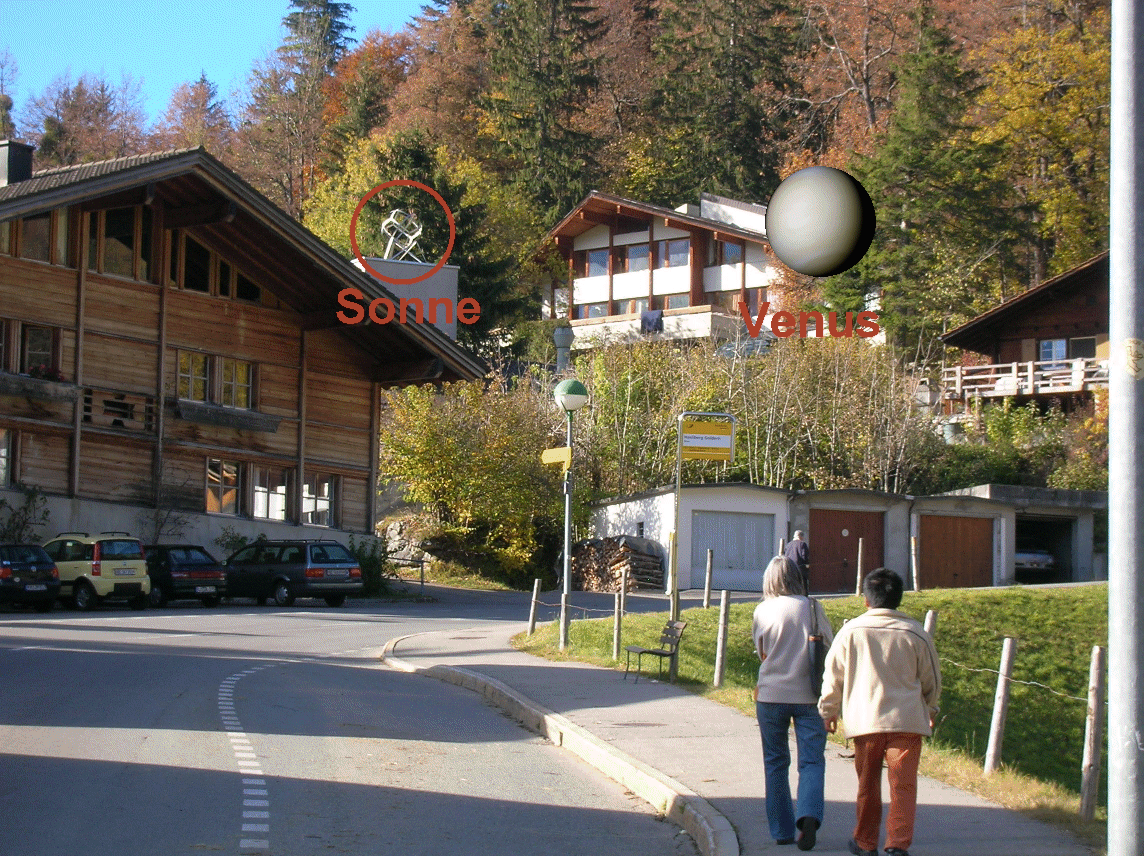
Venus is almost of the same size as our earth,but that's nearly the only common ground. The climate on Venus? horrible! 400 centigrades in the shadow – there will be always shadow under thick clouds with rain of sulfuric acid - sometimes space science might destroy romantic illusions! Don’t mind – be happy at the sight of this bright star!
50 m nearer to the sun –
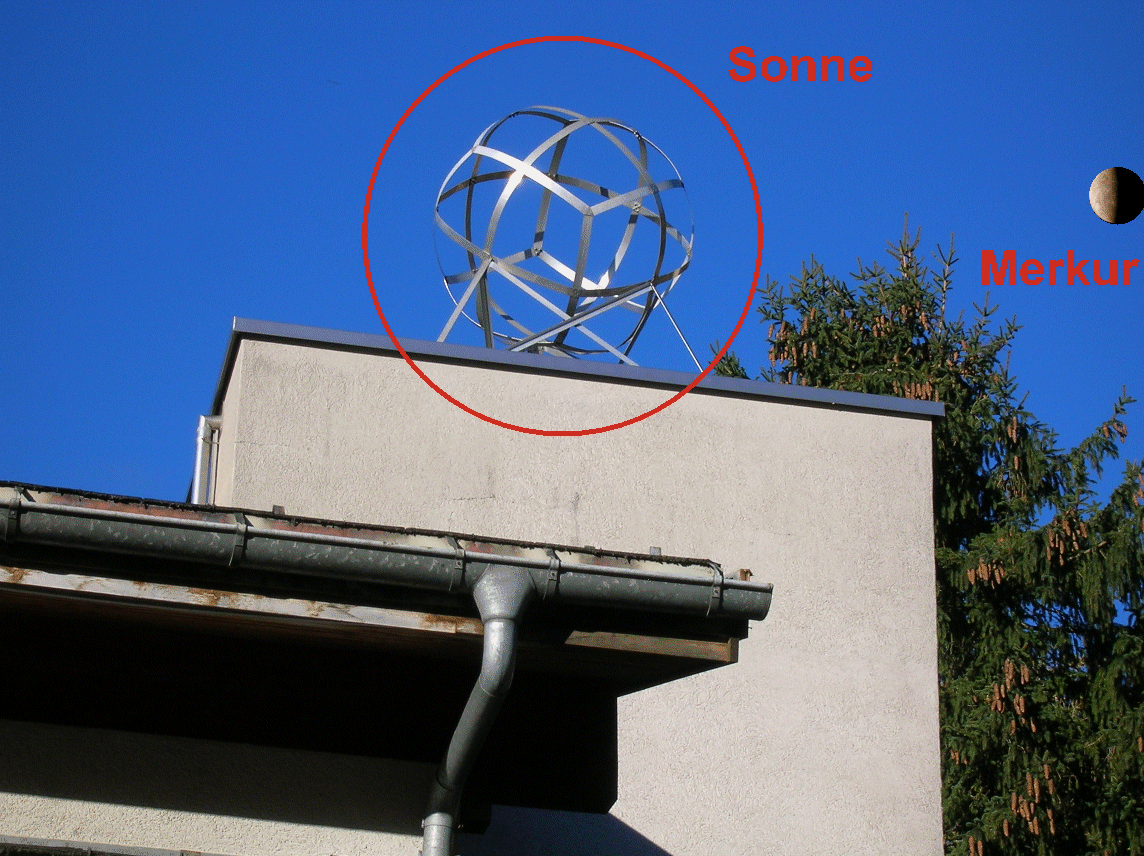
just before crossing the street (coordinates 658046|176791) to get still closer to the sun
– that is the distance Mercury has. Look, how big the sun is now at Mercury’s sky – heating without mercy! Not to neglect all the other radiation of this “nuclear furnace” - no atmosphere to absorb it!
No, directly to the ‘sun’ (coordinates 657991|176802)
on the roof – there is no way for visitors.

But at the wall there is a showcase with some German texts, pictures and a small earth pendant as described before.
You really missed numbers? Here they are! (Wikipedia...)
"Himmlische Verhaeltnisse"
(Sun, Moon and Earth, easy to see and if rounded easy to keep in mind)
Acknowledgements:

















